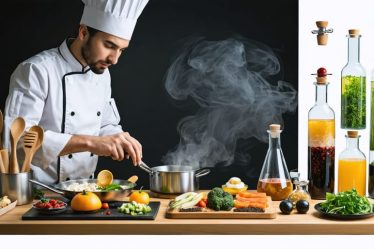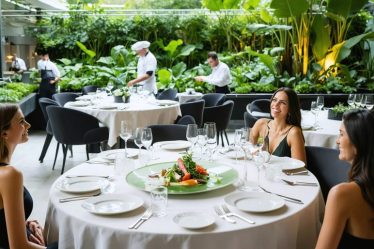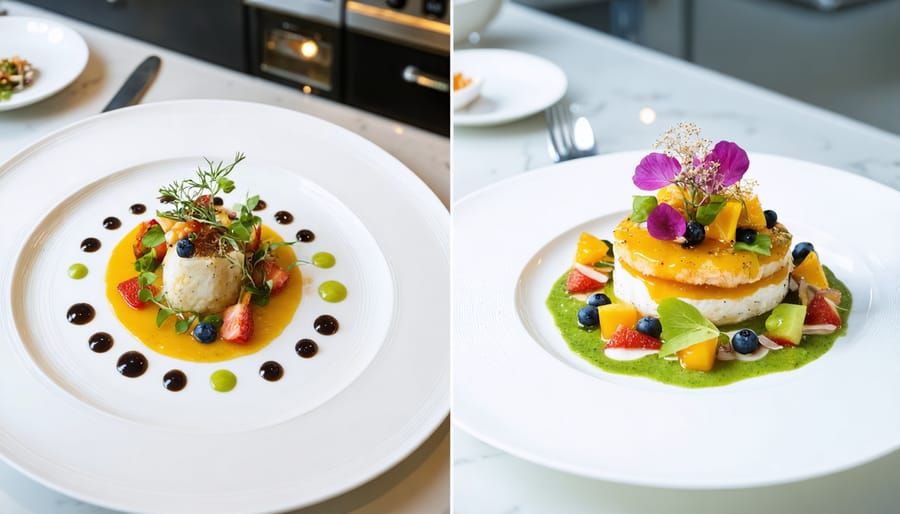
Transform a simple meal into an artistic masterpiece by mastering the delicate balance of color, height, and negative space on your plate. The art of plating goes beyond mere presentation – it’s about creating an experience that engages all the senses and helps enhance the dining experience from the very first glance.
Think of your plate as a blank canvas where each element tells a story. Just as a painter carefully considers composition, professional chefs understand that strategic placement of ingredients creates visual impact that rivals the finest restaurants. The good news? These sophisticated plating techniques aren’t reserved for culinary school graduates – they’re accessible skills any home cook can master with practice and attention to detail.
Whether you’re hosting an intimate dinner party or elevating your everyday meals, thoughtful plating transforms ordinary dishes into extraordinary dining moments that delight both the eye and palate. Let’s explore how to bring restaurant-worthy presentation to your home kitchen, one plate at a time.
The Psychology Behind Beautiful Plating
Have you ever noticed how a beautifully plated meal seems to taste better? It’s not just your imagination! The psychology of food presentation plays a fascinating role in how we experience our meals.
When we see an aesthetically pleasing plate, our brains release dopamine – the feel-good hormone – before we even take the first bite. This anticipation actually enhances our perception of flavor and creates a more memorable dining experience. I remember serving the same pasta dish two different ways at a dinner party: one simply tossed in a bowl, the other carefully arranged with fresh herbs and a thoughtful garnish. The plated version received significantly more compliments, despite being identical in taste!
Color contrast, height variation, and careful arrangement don’t just make food look pretty – they trigger psychological responses that heighten our enjoyment. Studies have shown that diners are willing to pay up to 18% more for well-presented dishes and report higher satisfaction levels with their meals.
Even the plate itself matters. White dishes make colors pop, while darker plates can create dramatic contrast. It’s amazing how these visual elements work together to create what scientists call “gustatory anticipation” – that magical moment when your mouth waters just from looking at a beautiful plate of food.
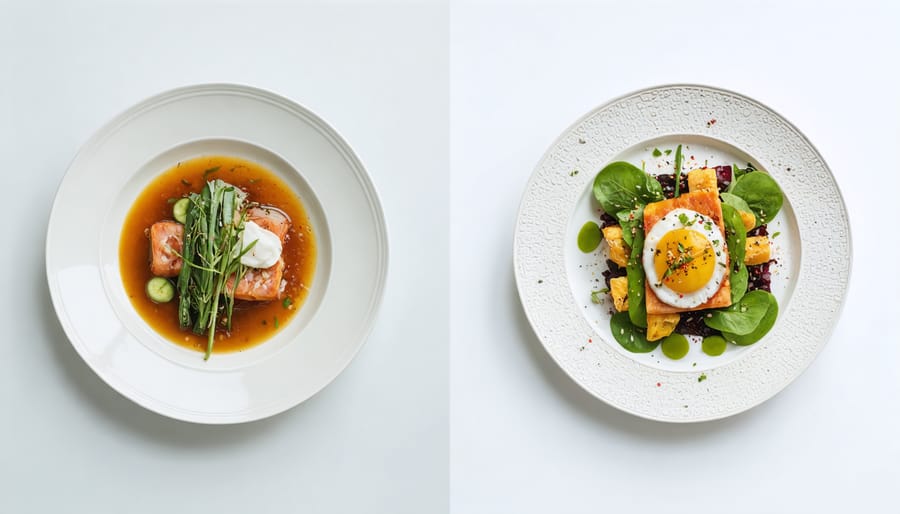
Essential Tools for Artistic Food Presentation
Must-Have Basic Tools
Let me share a little secret from my own kitchen adventures: having the right tools makes all the difference when creating Instagram-worthy plates! Start with a set of precision tweezers – they’re absolute game-changers for placing delicate herbs and microgreens with perfect precision. Keep a few squeeze bottles handy for creating those beautiful sauce drizzles and dots that make your plates pop.
Ring molds are another must-have in various sizes; they’re perfect for neatly stacking components and creating clean, professional-looking circular presentations. I also swear by offset spatulas for smooth sauce spreading and small paintbrushes for adding delicate touches of oil or reduction sauces.
Don’t forget about a good set of plating spoons – those long-handled beauties that help you create perfect swooshes and quenelles. And here’s my favorite tip: keep some clean kitchen towels nearby for wiping plate edges – it’s those little details that really make your presentation shine!
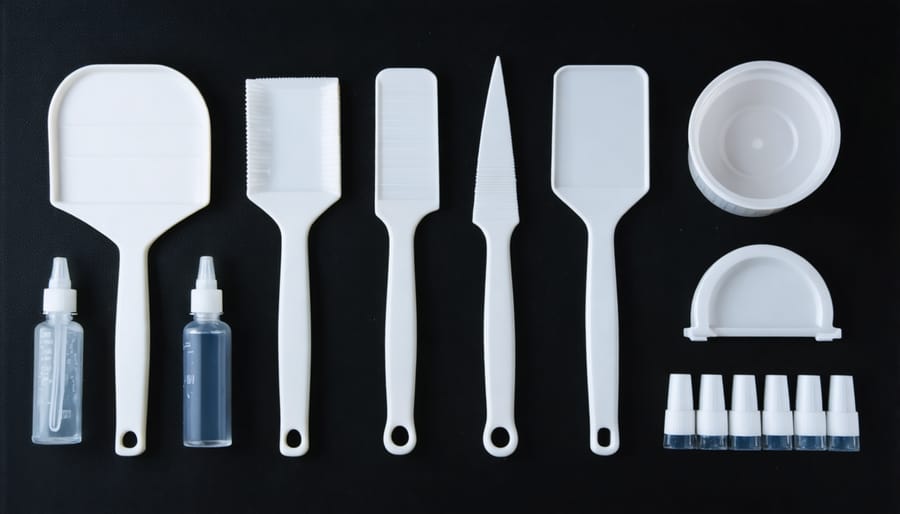
Nice-to-Have Specialty Items
For those ready to take their food presentation to the next level, a few specialty tools can make all the difference. I absolutely love using squeeze bottles for precise sauce applications – they’re perfect for creating those elegant dots and swooshes you see in high-end restaurants. Small offset spatulas are another game-changer, helping you spread sauces and purées with professional precision.
Consider investing in a set of plating tweezers, which make positioning delicate garnishes a breeze. Ring molds in various sizes are fantastic for creating perfectly shaped rice or tartare towers. And if you’re feeling particularly ambitious, a culinary torch can add beautiful caramelization to finishing touches.
One of my favorite recent discoveries is the plating spoon – its elongated shape helps create those gorgeous sauce swoops we all admire on cooking shows. Just remember, while these tools are wonderful to have, they’re not essential – creativity and patience can often achieve similar results with basic kitchen equipment.
Core Principles of Artistic Plating
Balance and Composition
Have you ever noticed how a beautifully plated dish can make your mouth water before you even take a bite? Learning to create visually balanced plates is like painting with food, and trust me, it’s easier than you might think!
Start by thinking of your plate as a canvas divided into thirds. Place your main protein slightly off-center – this creates more visual interest than centering everything. For height variation, lean delicate vegetables against your protein or stack components thoughtfully. I love using microgreens or herb sprigs as a finishing touch to add that perfect vertical element.
Color is your best friend when it comes to plating. Think about incorporating at least three different colors in each dish. For example, pair golden-seared salmon with vibrant purple cabbage and bright green asparagus. The contrast will make your dish pop!
Texture plays a crucial role too. Mix smooth purees with crispy elements, and add different shapes through your garnishes. I’ve found that combining round, angular, and flowing elements creates the most appealing compositions. Try placing a smooth swoosh of sauce alongside crispy potato coins, then finish with delicate herb leaves.
Remember to leave some negative space on the plate – it’s like taking a breath between bites. This white space helps highlight your carefully arranged elements and prevents the plate from feeling overcrowded.
Color Theory on the Plate
Have you ever noticed how a splash of vibrant colors on your plate can instantly make your mouth water? That’s color theory at work! Just like artists use their palettes to create masterpieces, we can use colors to transform our dishes into visual feasts.
Think of your plate as a canvas where complementary colors create magic. Remember the basic color wheel from art class? Those same principles apply here. Picture vivid purple beets against golden-yellow sweet potato puree, or bright green asparagus spears laying across coral-pink salmon. These color combinations aren’t just beautiful – they’re scientifically proven to enhance our dining experience.
When I first started playing with food presentation, I discovered that contrasting colors don’t just make food look better; they actually make it more appetizing. There’s a reason why restaurants often garnish with fresh herbs or edible flowers – that pop of green against other colors creates instant visual interest.
Try this simple trick: place three different colored elements on your plate in a triangle formation. For example, arrange seared tuna (pink) with black rice and bright green edamame. This creates a natural flow for the eye to follow and makes even simple dishes look professionally plated.
Remember, white plates are like gallery walls – they make your food colors stand out beautifully. Start with this neutral backdrop, and let your colorful ingredients take center stage.
Simple Techniques for Stunning Results
I remember the first time I tried to plate a special anniversary dinner at home – let’s just say it wasn’t quite Instagram-worthy! But over time, I’ve learned that creating beautiful plates doesn’t require professional training. Here are some simple techniques that will transform your everyday meals into visual masterpieces.
Start with the clock method – imagine your plate is a clock face. Place your protein at 6 o’clock, starch at 2 o’clock, and vegetables at 10 o’clock. This classic arrangement creates instant balance and makes any dish look more intentional. When I use this technique for family dinners, even my basic weeknight meals look restaurant-worthy!
Height is your secret weapon. Create layers by stacking components or leaning food against each other. Try placing your protein on a bed of rice, or prop sliced meat against a mound of mashed potatoes. Even a simple salad becomes dramatic when ingredients are thoughtfully layered instead of tossed together.
Color is crucial for eye-catching plates. Include at least three different colors in each dish – think seared salmon (pink) with purple roasted potatoes and bright green asparagus. Don’t forget to add small pops of contrasting colors through garnishes like microgreens, edible flowers, or herb oils.
Speaking of garnishes, they’re your finishing touch. Keep fresh herbs, citrus wedges, and edible flowers on hand. A light sprinkle of chopped parsley, a few drops of olive oil, or a delicate edible flower can elevate any dish from homemade to haute cuisine.
Remember the rule of odd numbers – grouping foods in threes or fives is naturally more pleasing to the eye than even numbers. Instead of four scallops, serve three or five. Rather than two asparagus bundles, create three smaller ones.
Finally, embrace negative space. Don’t feel pressured to fill the entire plate – letting certain areas remain empty creates visual breathing room and makes your food the star. Think of it as creating a frame for your culinary artwork.
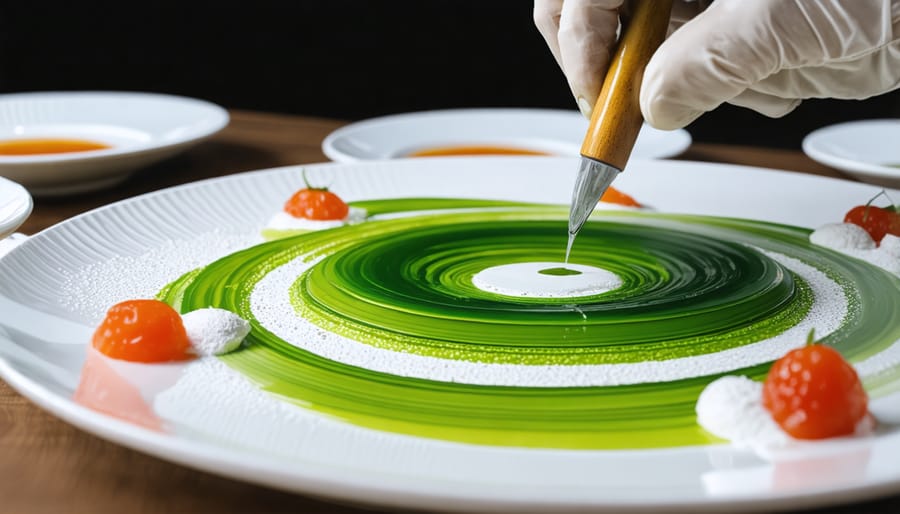
Remember, plating food isn’t just about making your dishes look Instagram-worthy – it’s about creating an experience that engages all the senses and brings joy to both the cook and those gathered around the table. Throughout this journey, we’ve explored everything from basic composition principles to advanced techniques that can transform your everyday meals into artistic expressions.
The beauty of food plating lies in its accessibility – you don’t need expensive tools or professional training to create beautiful presentations. Start with what you have, experiment with different heights, colors, and textures, and most importantly, let your personality shine through. Whether you prefer minimalist designs or love creating elaborate arrangements, there’s no “wrong” way to plate food as long as it brings you satisfaction and makes your meals more enjoyable.
I encourage you to start small – perhaps with a simple breakfast or lunch – and gradually work your way up to more complex presentations. Take photos of your creations to track your progress, and don’t be afraid to draw inspiration from restaurants, food magazines, or social media. Remember that even professional chefs started somewhere, and every plate is an opportunity to learn and grow.
Most importantly, have fun with it! Food plating should be a creative outlet that enhances your cooking experience, not a source of stress. So grab those tweezers, dust off that fancy plate you’ve been saving for special occasions, and let your culinary creativity soar. Your dining table is your canvas – make it beautiful!

